Social Spaces
Cafés and bars were important meeting grounds for artists and poets in San Francisco in the 1950s and ’60s. In both single sheets and elaborate accordionfolded sketchbooks, Barton recorded the atmosphere and denizens of places such as Foster’s Cafeteria, the Co-Existence Bagel Shop, and the Black Cat Café. Barton cultivated a cohort of pupils, whom he called the Academia Vinciana, referencing an informal school of fifteenth-century Milanese intellectuals to which Leonardo da Vinci is thought to have belonged. They gathered in cafés to draw under Barton’s tutelage. Each was encouraged by Barton to purchase a yatate, a portable Japanese writing set that holds a small inkpot and brush. Even when imprisoned on drug charges, as he was on several occasions, Barton drew ceaselessly, conveying the humanity of his fellow inmates.
Untitled [Seated man in Foster's Cafeteria]
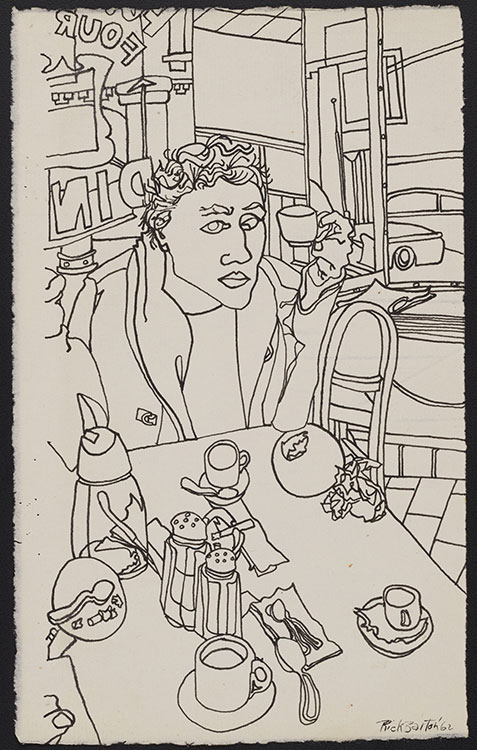
Foster’s Cafeteria on Polk Street in San Francisco was a popular gathering place for artists and poets. It was located beneath the Wentley Hotel, where poet John Wieners wrote his seminal book, The Hotel Wentley Poems, in 1958. H. D. Moe, another poet who resided in the hotel, remembered Barton as “kind of the philosophical mentor” of a group that spent time in the café below.
Rick Barton (1928–1992)
Untitled [Seated man in Foster’s Cafeteria], 1962
Pen and ink
Rick Barton papers (Collection 2374), UCLA Library Special Collections, Charles E. Young Research Library, University of California, Los Angeles
Untitled [Seated man with book in Foster's Cafeteria]
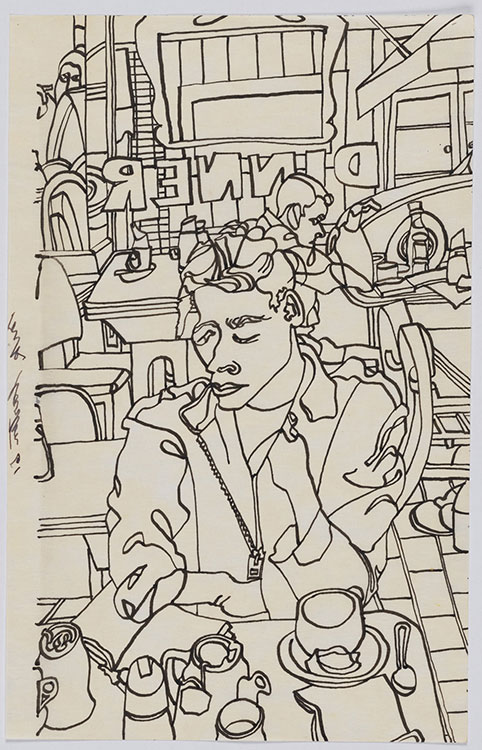
Rick Barton (1928–1992)
Untitled [Seated man with book in Foster’s Cafeteria], 1961
Pen and ink
Rick Barton papers (Collection 2374), UCLA Library Special Collections, Charles E. Young Research Library, University of California, Los Angeles
Untitled [Seated woman in Foster's Cafeteria]

Rick Barton (1928–1992)
Untitled [Seated woman in Foster’s Cafeteria], ca. 1961–62
Pen and ink
Rick Barton papers (Collection 2374), UCLA Library Special Collections, Charles E. Young Research Library, University of California, Los Angeles
Untitled [Seated figure in the Black Cat Café]
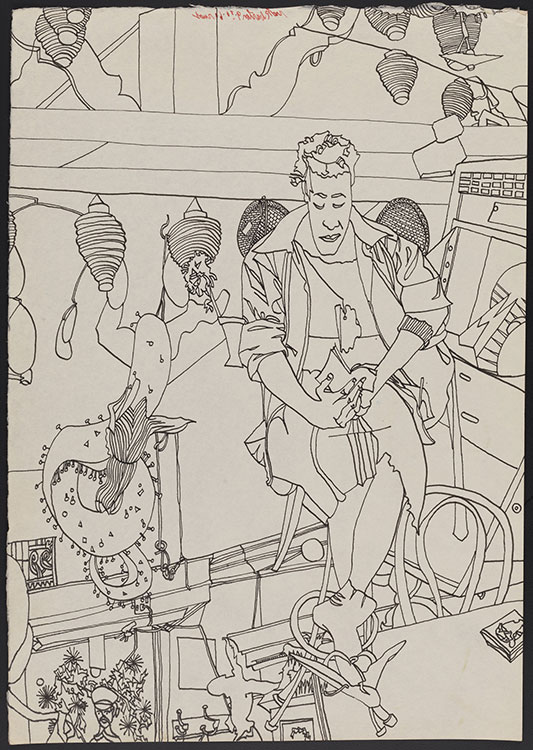
The Black Cat Café, located at the edge of San Francisco’s North Beach, was a cause célèbre in the fight for gay rights. In the 1940s it became a gathering place for the queer community, attracting the attention of state liquor officials, who often revoked the licenses of gay bars. For nearly fifteen years the Black Cat’s owner fought in court to retain its liquor license. The Black Cat gained additional renown for the popular drag performances of activist José Sarria, who mounted a historic, if ultimately unsuccessful, campaign for a seat on the San Francisco Board of Supervisors in 1961. The accurate portrayal of faces was not one of Barton’s strengths, but this figure, who is absorbed in a book, bears some resemblance to Sarria.
Rick Barton (1928–1992)
Untitled [Seated figure in the Black Cat Café], September 27, 1960
Pen and ink
Rick Barton papers (Collection 2374), UCLA Library Special Collections, Charles E. Young Research Library, University of California, Los Angeles
The Black Cat
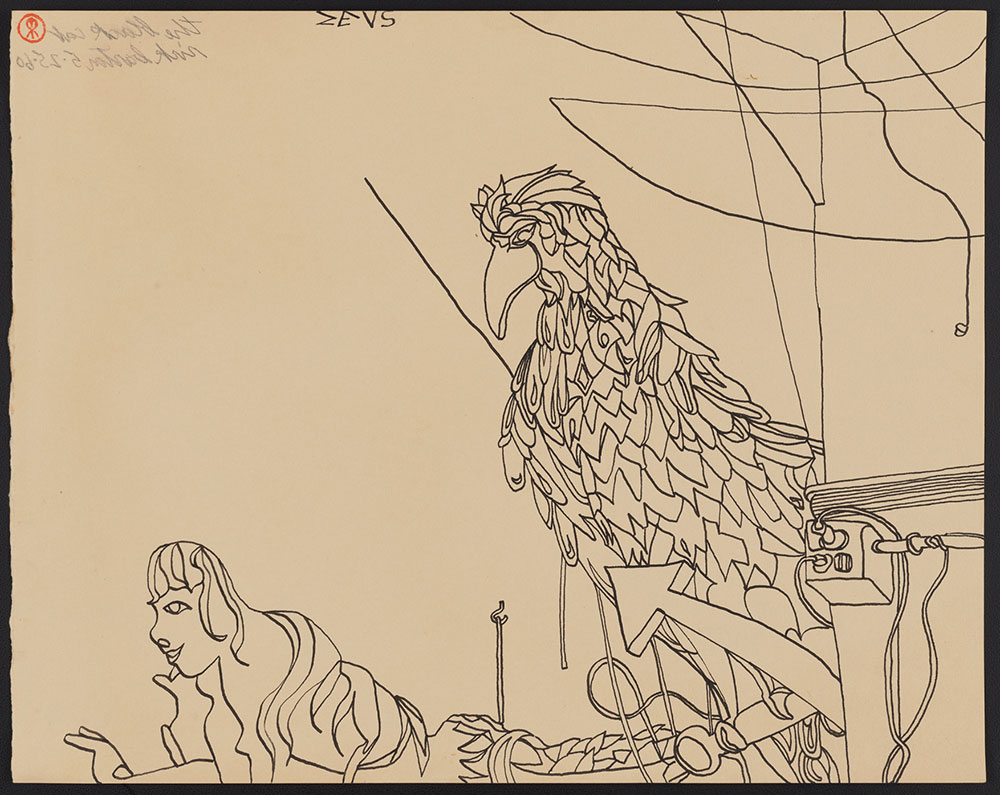
Rick Barton (1928–1992)
The Black Cat, May 25, 1960
Pen and ink
Rick Barton papers (Collection 2374), UCLA Library Special Collections, Charles E. Young Research Library, University of California, Los Angeles
Untitled [The Black Cat Café]
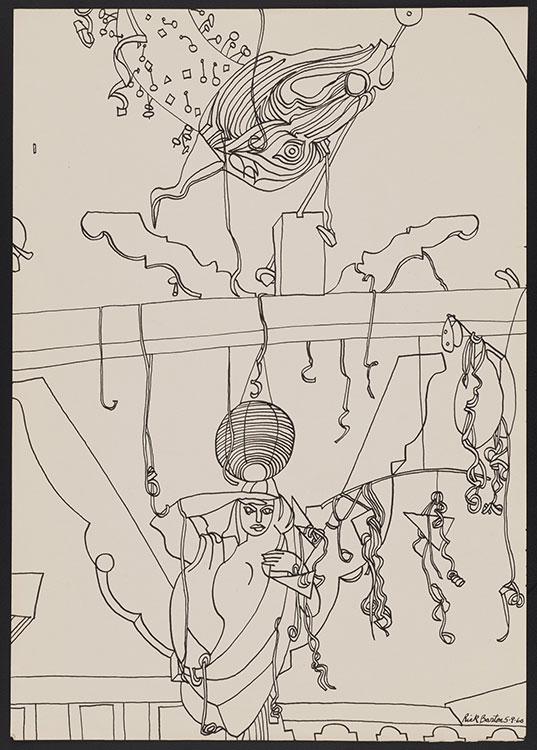
Rick Barton (1928–1992)
Untitled [The Black Cat Café], May 9, 1960
Pen and ink
Rick Barton papers (Collection 2374), UCLA Library Special Collections, Charles E. Young Research Library, University of California, Los Angeles
The Bagel Shop

Rick Barton (1928–1992)
The Bagel Shop, May 29, 1960
Pen and ink
Rick Barton papers (Collection 2374), UCLA Library Special Collections, Charles E. Young Research Library, University of California, Los Angeles
Lady Take Care

Rick Barton (1928–1992)
Lady Take Care, May 2, 1960
Pen and ink
Rick Barton papers (Collection 2374), UCLA Library Special Collections, Charles E. Young Research Library, University of California, Los Angeles
Central Market

In this aerial view of Los Angeles’s Grand Central Market, Barton excludes figures, instead prioritizing lighting fixtures and the scaffold-like structures that support shopping bags and wares. Despite the market’s reputation for crowds, its only inhabitants here are inert objects rendered animate by the energy of Barton’s line.
Rick Barton (1928–1992)
Central Market, Los Angeles, March 25, 1960
Pen and ink
Rick Barton papers (Collection 2374), UCLA Library Special Collections, Charles E. Young Research Library, University of California, Los Angeles
Untitled [Artist and onlookers]

Although the central, bespectacled figure in this small composition does not appear to be the artist himself, the scene does evoke a meeting of what Barton called his Academia Vinciana. David Archer Nelson (b. 1941), a member of this group of largely unknown artists, recollected, “At one time there were half a dozen of us or more, in North Beach, all using yatates, painting at café tables. We often sat at the same tables working together, Barton of course holding court.” Nelson also recalled that when Barton, a voracious reader, encountered a similarly erudite interlocutor, they would argue “beautifully in the Socratic style.”
Rick Barton (1928–1992)
Untitled [Artist and onlookers], 1961
Pen and ink
Rick Barton papers (Collection 2374), UCLA Library Special Collections, Charles E. Young Research Library, University of California, Los Angeles
Eleven Double You Four Plus
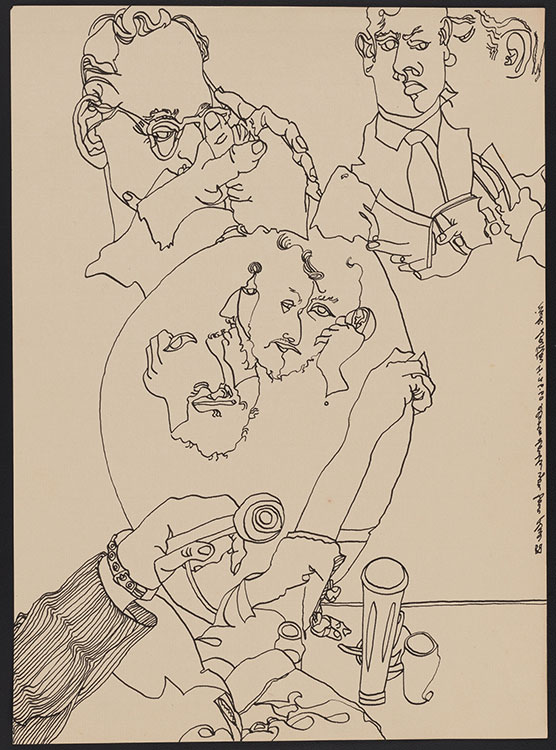
Rick Barton (1928–1992)
Eleven Double You Four Plus, 1960
Pen and ink
Rick Barton papers (Collection 2374), UCLA Library Special Collections, Charles E. Young Research Library, University of California, Los Angeles
Untitled [Inmates reading]
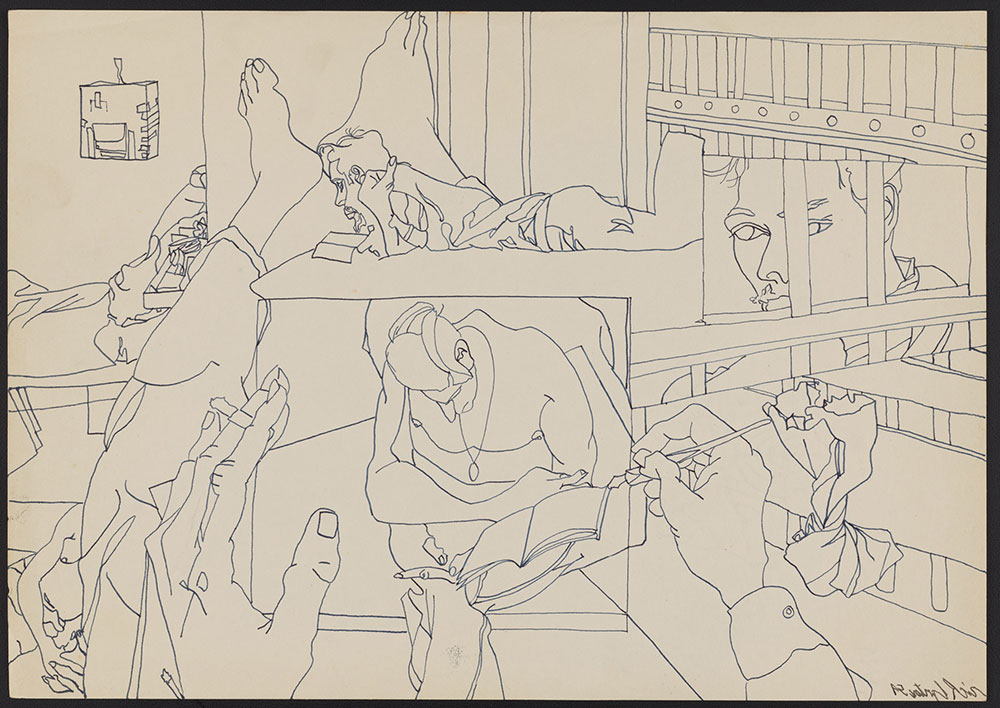
In July 1959, a Sausalito newspaper reported that Barton had been arrested on a charge of “furnishing narcotics.” Just a few weeks earlier, the same newspaper had announced an exhibition of his drawings at the Tides Bookstore. While in prison that year, Barton made this metacomposition of the artist sketching his fellow inmates, as well as the drawings nearby. In these works, as in drawings made during later periods of incarceration, Barton portrays his cellmates as sensitive souls.
Rick Barton (1928–1992)
Untitled [Inmates reading], 1959
Pen and ink
Rick Barton papers (Collection 2374), UCLA Library Special Collections, Charles E. Young Research Library, University of California, Los Angeles
Untitled [Reclining inmates]
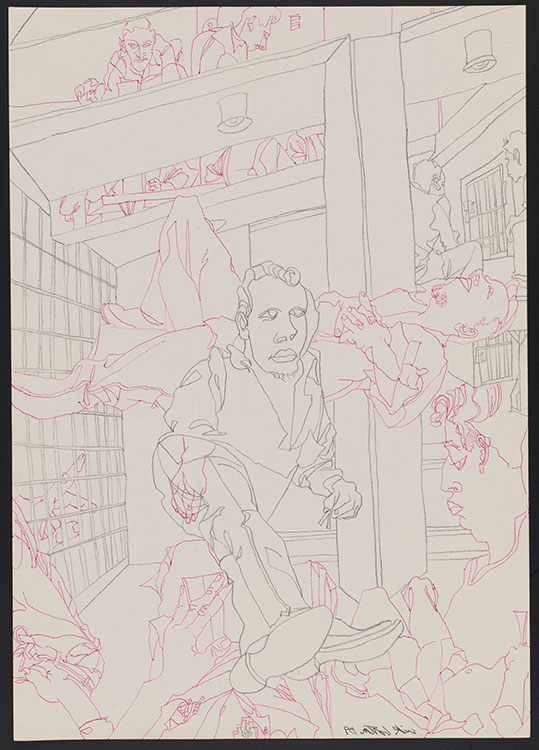
Rick Barton (1928–1992)
Untitled [Reclining inmates], 1959
Graphite and red ballpoint pen
Rick Barton papers (Collection 2374), UCLA Library Special Collections, Charles E. Young Research Library, University of California, Los Angeles
Untitled [Inmates]

Rick Barton (1928–1992)
Untitled [Inmates], 1959
Red and blue ballpoint pen
Rick Barton papers (Collection 2374), UCLA Library Special Collections, Charles E. Young Research Library, University of California, Los Angeles
Untitled sketchbook, 1961


Barton probably made dozens of books like the two shown here throughout his life. The accordion format allowed him to create continuous images over time, multiplying his connections in a web-like style that conflates drawing and writing. Completed between 1959 and 1962, all thirteen of Barton’s known sketchbooks reside at Northwestern University Libraries, ten of them accordion style.
Rick Barton (1928–1992)
Untitled sketchbook, 1961
Brush and ink on accordion-folded book
Charles Deering McCormick Library of Special Collections, Northwestern University Libraries; MS 125
Untitled sketchbook, 1962

Barton’s preferred format when working in cafés such as Foster’s Cafeteria was the accordion-folded book, in which he painted using a yatate, comprising a brush and portable inkpot. Artist and poet Etel Adnan (1925–2021), who met Barton in the early 1960s, credited him with introducing her to this format:
Before that fateful afternoon, I had never seen any folding books. He opened the one he was working on, put it on the table after having pushed his drink and dried the surface, and I was in a state of wonder: tiny heads were drawn, each with its own character, the customers of the café were recorded with the utmost care, filling every page of the book the way they were crowding the place as well as Rick’s mind. Here
and there, tucked in what were empty places on the paper, were fingers holding cigarettes, swirls of smoke, an obsessed and obsessive mass of humanity running like a river all along the book which was so to speak growing in length, like a ribbon. Thus one of the
most lasting of my artistic impressions was happening amidst a crowd in the magic atmosphere of a San Francisco which was still primarily a harbor with all the feelings of alcohol and transiency that harbors create.
Rick Barton (1928–1992)
Untitled sketchbook, 1962
Brush and ink on accordion-folded book
Charles Deering McCormick Library of Special Collections, Northwestern University Libraries; MS 95e
